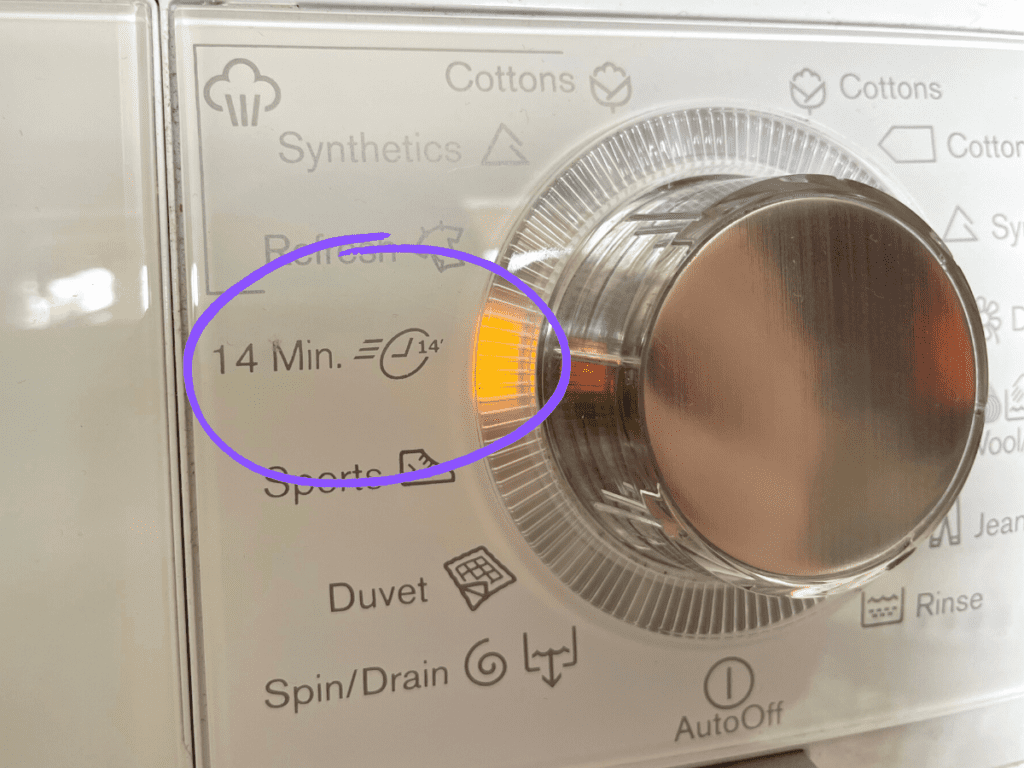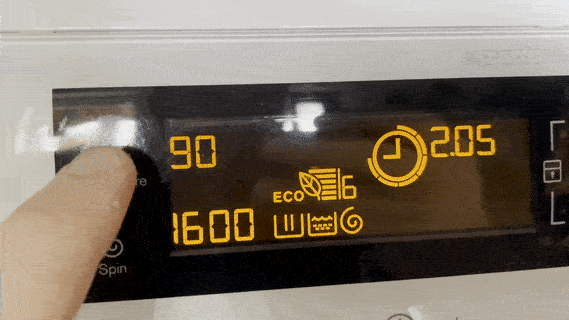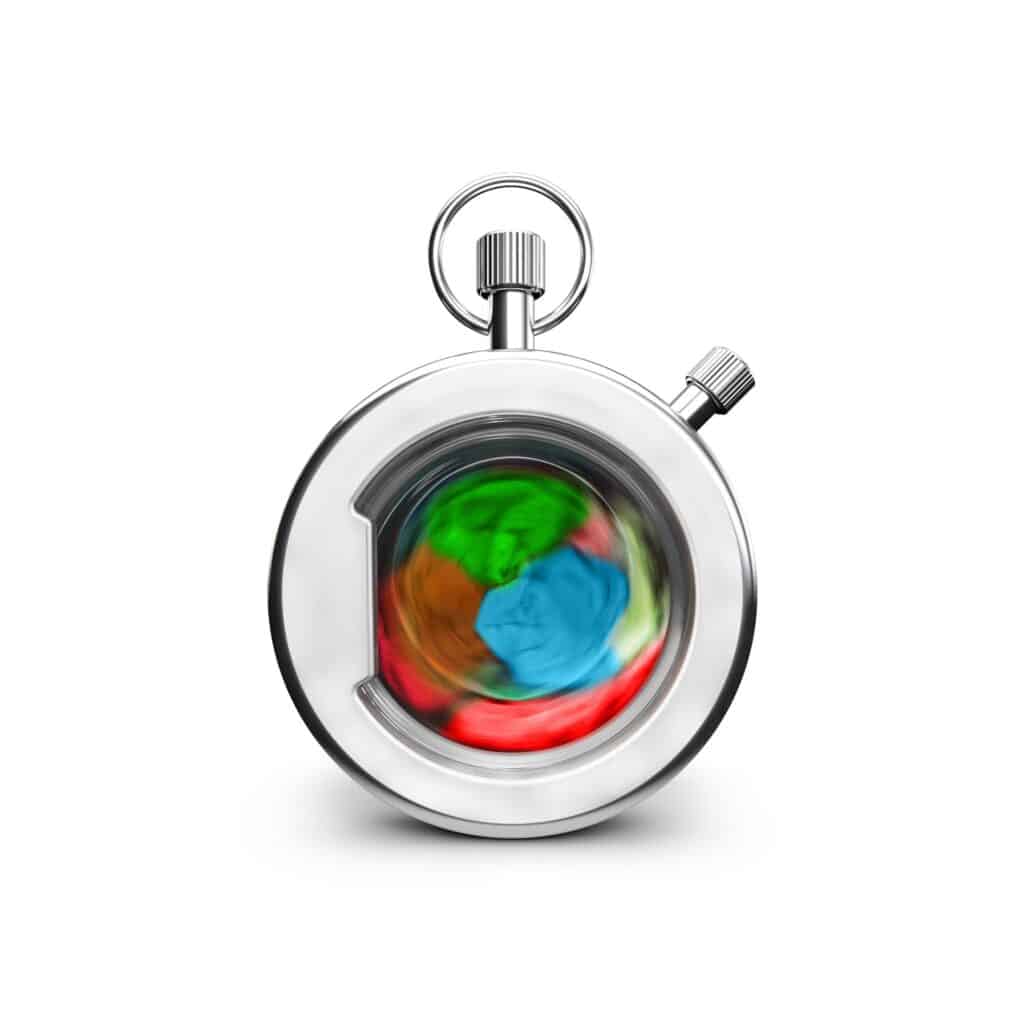Your washer has many settings for the different types of laundry you need to wash. Not all of these settings are used equally. Some settings are for very specific purposes, such as wool washing.
And unless you wear wool fabrics all year round, chances are you will rarely, if ever, use this setting.
But other settings like the quick wash setting need to be used more often because they offer many benefits.
A quick wash setting often takes considerably less time to finish than other cycles. It also requires less laundry detergent and less water. When you have a slightly dirty load of laundry, then you would want to use the quick wash cycle to save on water, energy, and detergent. It also protects the fabrics from unnecessary long exposure to the chemicals in the detergent.
Of course, the quick wash is not the ideal setting for every type of laundry. For all its benefits, it too has some drawbacks.
Read more to find out all about the quick wash setting and how to use it more effectively to do your laundry.
What is Quick Wash?
A quick wash is a setting on the panel of your washer. It’s specifically programmed for light loads of laundry where the clothes are easy to wash and certainly don’t have any stains on them.
The average duration of the quick wash cycle can be anything between 15 and 30 minutes long, depending on the washer brand and model you have. Although some washers have quick wash settings 40 minutes long.

Another factor that decides the length of the quick wash cycle is the water temperature. In general, the washer starts at 85 degrees Fahrenheit. As you increase the temperature, the washer increases the time it takes to heat the water and finish the cycle.
This is why the quick wash setting varies between one washer and the next and will take less time in the summer than in the winter when the running water is colder.
Quick Wash in the Right Temperature

When using the quick wash setting, you often have to select another setting to go with it. Namely, the water temperature.
Since you’re going to give your clothes a quick wash, you need to make sure that the water has the right temperature to get rid of the light stains in the short time the clothes are in there.
But as we all know, when it comes to washing fabrics, there’s no one temperature setting that works for everything.
A few factors come into play here and help you decide on the right temperature of the water for this specific load of laundry. The type of fabric is one of them, and whether it has bright colors, dark colors, or it’s white is another factor.
To put things into perspective, we can safely state that there are three temperature settings. These are cold water, warm water, and hot water. Each setting is more suited for specific fabrics and particular colors.
Here’s the lowdown of each water temperature setting and the type of clothes that correspond to it.
Cold Water
The temperature of this setting ranges between 35 to 86 degrees Fahrenheit. You can safely use the cold water setting with all types of fabrics, including delicates.
It is also safe with colors both bright and dark. If you’re worried that the clothes might shrink in hot water, then you should wash them in this setting. As long as the clothes are just lightly soiled, then the cold water setting is the right one.
Warm Water
In this setting, the temperature of the water averages between 86 and 104 degrees Fahrenheit. It’s the most common temperature setting for daily washing.
This is especially true of overly dirty clothes such as workout clothes and activewear.
You can safely select this setting for synthetic fabrics and blends. However, it’s not the right choice for clothes that could shrink. So always check the washing instructions.
Hot Water
This is the highest temperature setting in the washer, and it brings the water to temperatures between 104 to 140 degrees Fahrenheit. It’s the kind of temperature that works on tough stains and breaks down grease and oil spots on the clothes.
In general, these are the types of clothes that require a deep cleaning, such as bed sheets, linens, pillow cases, baby clothes, underwear, and cotton fabrics.
If you need to wash your clothes in such high temperatures, then a quick wash setting will not work for you.
However, in some cases, you might want the hot water of a quick wash cycle to remove the traces of a pre-treated stain without the need for a deep clean cycle or even a regular cycle.
Benefits of Quick Wash Setting
So why exactly would you want to use the quick wash setting? If you haven’t used it so far, you probably think it’s just one of those settings that do nothing but make the washer panel look cool and more sophisticated.
But the quick wash cycle is one of the most underrated settings on your washer. Here are some of the benefits of this often overlooked setting.
- Washes Quickly: It’s a no-brainer that the quick wash cycle finishes ahead of any other cycle. If you have no time to wait for an hour or two to get your laundry into the dryer, the quick wash setting will get the job done in half the time or less.
- Stored Clothes: When you store your seasonal clothes in the wardrobe, they get a musty smell sometimes due to dampness. Thes clothes need some refreshing before you can wear them again. The quick wash cycle is meant for just that.
- Slightly Dirty Laundry: Not all your clothes need a deep clean cycle or long hours in the washer. Your work clothes and everyday wear rarely get more than slightly dirty with sweating. These should go under the quick wash category.
- Small Loads: When you only have one or two items to wash, engaging the washer into a regular cycle seems like a waste of time, water, and electricity. Just set it to a quick wash, and you’re done in no time.
- Sixty Percent Less Energy: On average, the quick wash cycle not only takes half the time to finish but also cuts down on water and energy consumption by about the same rate. It is estimated the quick wash saves up to 60 percent of energy. This saves you money on your utility bills.
- Saves the Washer: Since you only use the washer for short periods of time every time, this helps you preserve the washer and minimizes the problems you get with maintenance and breakdowns.
- Protects the Clothes: The same applies to the clothes you wash. They get less exposure to detergents and chemicals, which prolongs their lifespan and keeps the colors from fading too quickly.
Quick Wash Best Practices

There are situations where a quick wash setting is just the right cycle to choose. The more you get familiar with the rarely-used setting on the washer, the more you’ll love it.
But just like every other setting related to the washer and dryers, you’ll need to learn the best practices for the quick wash cycle in order to get the most out of it.
Here are a few tips from the experts.
- Forty percent Loads: At the risk of stating the obvious, you should only fill the washer with small loads when using the quick wash setting. Too many clothes defeat the purpose and impact the degree of cleanliness you’ll get. The golden rule of thumb is to only load the washer with 40 percent of its maximum capacity with the quick wash cycle.
- Only Lightly Dirty Clothes: If the clothes have stains or have been through a rigorous gym session or one exceptionally long yoga class, chances are the quick wash cycle will not be enough to clean these clothes. So limit the laundry to daily wear and office wear.
- More Detergent: Experts recommend that you use more laundry detergent with the quick wash cycle to get better results. Use your discretion when increasing the detergent dose. You wouldn’t want to go overboard with the detergent, which might not get fully rinsed off the laundry. If you normally add 1 unit of detergent, then increase it to 1.2, and so on until you find the sweet spot.
I also wrote a guide on what to do if you’ve used too much detergent that may interest you.
When Not to Use Quick Wash
For all its benefits, the quick wash is not the right setting for all types of laundry situations. Yes, it’s the go-to setting if you have a laundry emergency, but because of the limitations of both time and water, the quick wash is not the answer to every laundry question.
Here are a few situations where you should not use the quick wash setting and look for another cycle on the washer instead.
- Stubborn Stains: If your clothes have stains on them, then you would want to set the washer to deep clean instead of quick wash. The amount of time the clothes get the detergent treatment is quite low, which means that the stains will not be affected with the quick wash. The same applies to smelly clothes such as work uniforms and activewear.
- Big Loads: If you already have a big load of clothes that will fill the washer to its capacity, then you shouldn’t use the quick wash. The laundry will come out no better looking or smelling than when it went in. These loads need a longer washing cycle and more time in the washer than what the quick wash provides.
- Denim Fabrics: The washer in the quick wash setting doesn’t spin as fast or for as long as with other settings. If you wash denim under this setting, it will not get the cleaning you expect, and the garments might come out with suds marks on them due to the poor spinning. This also applies to other heavy fabrics such as towels and curtains.
- Fabrics that Require Rinsing: Good rinsing is not part of the quick wash setting. The washer does everything quickly, which means that the clothes will not get enough time in the clean water to rinse off the detergent. Wool clothes tend to absorb a lot of soap and need more than one rinsing cycle to get fully clean. Avoid the quick wash setting with these types of clothes.
How to Use Quick Wash Effectively
Before you set the washer to the quick wash setting, you need to decide whether your clothes will actually benefit from this short and sweet cycle or not.
For example, if the clothes have germs, then you need to wash them in temperatures around 140 degrees Fahrenheit to kill those germs. This applies to underwear, baby clothes, bedsheets, and work clothes in less than healthy environments.
Also, you should pay attention to the detergent you use. Since the quick wash setting doesn’t rinse heavy clothes that well, chances are you’ll have trace amounts of the detergents on them even after running them through the dryer.
If you use biological detergents that contain bleach or enzymes, you risk getting these chemicals in contact with your skin when you wear the clothes again. This can be problematic for people with sensitive skin.
One last thing to keep in mind is that the washer is more likely to have mold build-up and develop a musty smell with the quick wash setting than in other settings.
That’s because the quick wash setting uses low-temperature water that triggers mold and mildew formation. So run the washer on an empty cycle with the maximum temperature to get rid of the germs.
Conclusion
When you have a laundry emergency and need a shirt or pants the next day, then the quick wash setting is the right choice for you.
It helps you with small loads and doesn’t use as much electricity or water as the other cycles on the washer. It also prolongs the lifespan of the washer and protects colors.
I’ve created a comprehensive guide on how to use all the settings on your washing machine that may interest you to read next.

I’m an expert wardrobe organizer and a bit of a clean freak. I created this website and its YouTube channel to share practical guides about laundry and organizing. My teachings have been featured in multiple large news publications, and I’ve self-published two wardrobe organizing books and an entire course on the subject.

